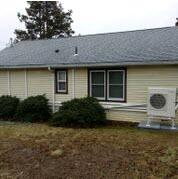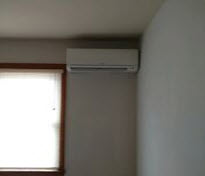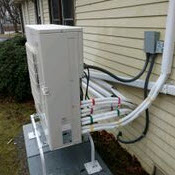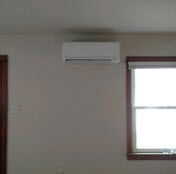Ductless Panels Supplement Oil Heat, Add AC in Slatington, PA Ranch
 Like many people in Northeastern Pennsylvania, our homeowner used oil heat for his ranch home in Slatington, PA. But, this wasn’t always enough to keep him warm. And, his home never had air conditioning. A ductless heat and cooling system would solve both these problems.
Like many people in Northeastern Pennsylvania, our homeowner used oil heat for his ranch home in Slatington, PA. But, this wasn’t always enough to keep him warm. And, his home never had air conditioning. A ductless heat and cooling system would solve both these problems.
Problem: A ranch home in Slatington, PA with oil heat had hot and cold spots in the winter. Some parts of the home never got warm enough. In the summer, our homeowner used old, inefficient window air conditioners to cool off. He wanted to save money on both his heating and cooling bills.
Solution: Installed a Mitsubishi ductless panel system. This supplements the baseboard oil heat in the cold weather. And, it replaced the window units in the summer.
How Ductless Heating And Cooling Works
A Mitsubishi mini-split system works by delivering heating or cooling to the home through ductless panels, or air handlers. It’s just as powerful as a central HVAC system. But, it uses less energy and is much easier to install.

Imagine a traditional system of ductwork vents. The ducts transport the air, which comes out of a vent in each room. Instead of ducts, this setup has thin, plastic tubing that bends easily.
Rather than take up a lot of space, this piping fits neatly between the rafters in walls. Our installers snake it through the house like electrical wiring.
The treated air gets circulated by the panels or air handlers. These sit high on a wall, out of sight. And, they’re whisper-quiet. Even at full blast, you can’t hear a panel working unless you’re standing right under it in silence.
On the other end, the climate control is provided by an outdoor heat pump. We’ll look at how that component works a little later. For now, let’s see how this setup works with existing baseboard heat and as a replacement for window ACs.
Using Zoned HVAC To Supplement Baseboard Heat

A mini-split makes a great supplement to oil heat in this home because it’s not a central system. That’s different from the baseboard setup the house currently has. Instead, each panel has a thermostat. Therefore, our homeowner can set them all separately.
We mentioned before that this ranch home regularly had hot and cold spots in the winter. This occurs because not all the rooms are the same temperature, to begin with.
Instead, some are colder than others. But, the thermostat can only read the temp in one room.
In this case, that’s the living room. And, it works based on only that reading.
Often, the bedrooms are colder than the living room. But, the system shuts off once that space is warm enough. That leaves the bedrooms still chilly.
The new system takes care of that. Now, each air handler works separately to ensure its zone is at the temp our homeowner wants. In the winter, oil heat does most of the job. The panels do the rest.
This setup also offers more flexibility. Our homeowner prefers his bedroom a little warmer than other rooms. Now, he sets just that zone how he wants it. That won’t affect the others.
Similarly, he can also raise the temp in the living room if company is over. And, he can turn just that one down when they leave, or when he’s going to sleep.
Adding Air Conditioning And Saving Money

The mini-split offers cooling as well as heating. And, since it uses that heat exchange process, it does the job for much less money than window air conditioning.
The process works thanks to a heat exchange process. In the summer, the pump draws heat from the home. Then, it cools the air while it’s in the machine and sends it back inside.
In the winter, the system works almost in reverse. It draws in the small amount of heat outside. Then, using a compression system, it amplifies the warmth and sends it inside.
This creates a cycle of heat exchanges that either cools or warms the house. Since this is a naturally-occurring process, it doesn’t take a lot of energy to work.
Other heaters burn fuel or use electricity to create warmth. A heat pump just needs a little bit of energy to begin the process.
Similarly, that’s also much less electricity than an air conditioner requires. It uses much less energy than central air, and especially window air units.
And, the efficiency doesn’t stop there. The tubing is sealed tight. That means no treated air escapes before reaching the air handlers.
Finally, those panels circulate air quickly and efficiently. The quicker they get the zone to the temperature our homeowner wants, the sooner the system shuts off.
For these reasons, mini-split systems such as these are certified Energy Star appliances. They meet federal standards showing they use less energy than comparable units.
Now, our homeowner doesn’t use his baseboard heat as much as he used it. In the fall and spring, the mini-split does the job. He only needs the oil heat when it gets really cold.
Since the ductless panels use less energy, he pays less on his electric bill during those months. And, our homeowner got approved for zero-interest financing. This way, he’ll pay just a little each month toward the system. And, since his bills are lower than before, that amount feels even smaller.
Are you looking for a better way to heat and cool your home? Contact us, and we’ll design a system that’s perfect for you!
